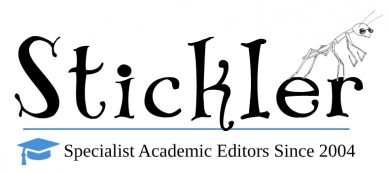The style of the American Psychological Association (APA) is one of the most widely used across academia, particularly in the social sciences, psychology, education, and related fields. Many top-ranked business and management journals also use APA. The style covers citation and referencing; paper structure; formatting of headings, tables, and other document elements; and so on. This blog post outlines the key elements of APA style—though it should be noted that many journals (e.g., those published by the Academy of Management) use their own style based on APA.
The Basics of APA Style
- Title Page: The title page includes—you guessed it—the title of the paper, the author name(s), the institutional affiliation, and a running head. The running head is a short version of the paper’s title and is also included on each subsequent pages in the header section of the document.
- Abstract: The abstract summarizes the paper’s main points, including the research objectives, methodology or approach, results, and conclusions. It typically ranges from 100 to 250 words.
- In-text citations: APA style uses an author–date citation system. This means that when sources are cited within the text, the author’s last name and the publication year are included in parentheses—for example, “(Smith, 2023)” or “Smith (2023)” (depending on the sentence structure). Page numbers should also be included when using a direct quotation—so “(Smith, 2020, p. 45).”
- References: The reference list should include all sources cited in the paper (and none that are not directly cited). The information to be included varies according to the publication type, but, broadly speaking, each entry includes the author’s name, publication year, title, and publication information (e.g., journal title, and volume, issue, and page numbers for journal entries; or publisher for books). The reference page is organized alphabetically by the author’s last name.
- Headings: APA style employs a hierarchical system of headings to organize content, ranging from level 1 (main section headings) to level 5 (subheadings). This aids in presenting a clear structure and enhancing the readability of the document.
- Font and formatting: APA recommends using a clear and legible font, such as Times New Roman, with 12 pt. font size. Double-spacing should be used throughout the paper, including the title page, abstract, main text, and references.
Why APA Style Matters
Consistency: APA provides a standardized format for citations and references, ensuring that your sources are attributed correctly and uniformly. It also provide recommendations on spellings and word presentation (e.g., use of hyphens, capitalization). This consistency lends credibility to your work, allows readers to easily locate and verify the sources you’ve used, and ensures your work conforms to academic standards.
Clarity: The structured organization of APA style, including headings and subheadings, enhances the clarity of your writing. It helps readers follow your arguments and navigate through complex topics.
Academic integrity: Properly citing sources is a matter of academic integrity. APA style emphasizes giving credit to the original authors and researchers, preventing plagiarism and upholding ethical writing practices. APA also provide recommendations on language use (e.g., avoiding the use of “minorities” to describe people of color and other underrepresented groups), which can help you avoid using outdated terminology.
Professionalism: When you apply APA style to your writing, you demonstrate a commitment to professionalism and scholarly rigor. This is especially important in academic and professional contexts where adherence to standards is highly valued.
Mastering the intricacies of APA style is a valuable skill for any writer engaged in academic or research-oriented work. It is used by some of the highest-ranked journals, and its guidelines provide a structure that promotes clarity, consistency, and proper attribution of sources.
And remember, if you’re in any doubt, we can help. Our editors are experts in applying APA style in particular, and are up to date on all the changes brought in with the seventh edition. Plus, application of style guidelines is included in all orders—just provide the name of your journal or a relevant link or style document when you send your work over, and we’ll make sure your work is compliant.

